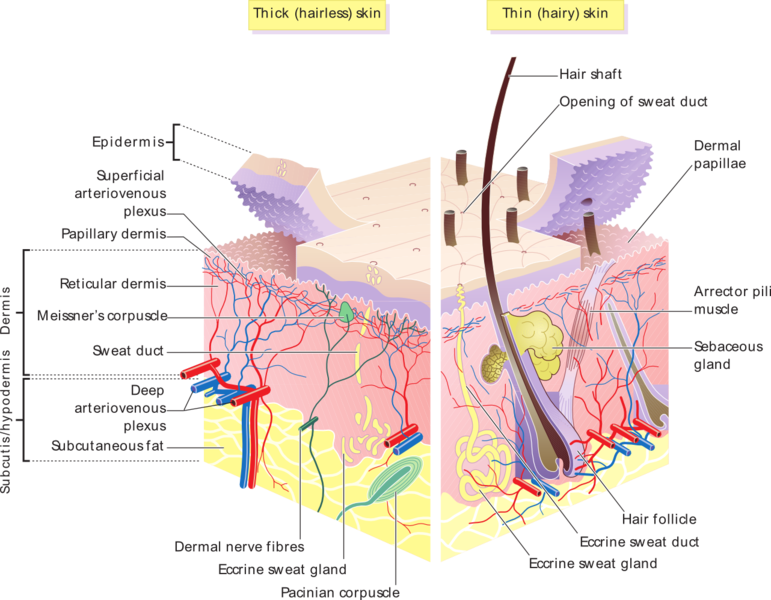Human Skin Anatomy – Structure of Epidermis and Dermis Layers
The human skin and its related structures are known as the integumentary system. It is the largest organ in the body measuring 2 square meters in the average adult. Being the outermost structure, it is often the focus of much attention with a poor understanding of its anatomy and physiology. It can be considered as the most resilient organ in the human body as it is bombarded on a daily basis with a number of insults yet is able to withstand these attacks and continue functioning throughout life.
Layers of the Human Skin
The skin is composed of two layers, the outer epidermis and deeper dermis. There are two other layers worth noting, namely the basement membrane between the epidermis and dermis, and the hypodermis / subcutis beneath the dermis. These layers are often considered as part of the epidermis and dermis.
Picture from Wikimedia Commons
The Epidermis
The epidermis is the outermost layer of skin about 0.1 to 0.2 millimeters thick. It is made up of four types of cells :
- the keratinocytes which make up 90% of the epidermis,
- the Langerhans cells, melanocytes and Merkel cells which constitute the remaining 10% of the epidermis.
The keratinocytes, apart from being the most abundant of the epidermal cells, are also the most important in that it allows the skin to conduct its most basic function – protecting the internal environment of the body. It does this by manufacturing a number of proteins, mainly the different types of keratin, as well as lipids. As these cells emanate from the deepest layer of the epidermis known as the stratum basale (or stratum germinativum), it undergoes various stages of rearrangement and apoptosis (cell death).
By the time this process is complete, the outermost layer of the epidermis (stratum corneum) is made up of these dead highly-keratinized cells sealed by a layer of lipid and arranged in a manner that creates a firm, waterproof barrier. These gradual changes between the stratum basale and straum corneum contributes to the different arrangements seen as the five layers of the epidermis. This includes :
- Stratum basale (innermost)
- Stratum spinosum
- Stratum granulosum
- Stratum lucidum
- Stratum corneum (outermost)
The epidermis has no blood supply of its own but receives oxygen and nutrients from the highly vascularized dermis. This travels across the basement membrane that anchors the stratum basale of the epidermis to the underlying dermis. The other types of epidermal cells also play important roles in the functioning of skin.
- Langerhan cells play an important role immune activity by exposing foreign antigens to lymphocytes.
- Melanocytes synthesize the pigment melanin which protects the skin against ultraviolet light.
- Merkel cells may play a role in the sense of touch although this has not been conclusively substantiated.
The Dermis
The dermis is the deeper layer of the skin separated from the epidermis by the basement membrance. It is about 1 to 4 millimeters thick and contains a variety of cells which carry out many different functions. The dermis contains a vast network of nerve endings, blood vessels and connective tissue. The main type of cell found in the dermis is the fibroblast which produces various fibers like collagen and elastin. A number of different types of immune cells are also abundant in the dermis. Broadly, the dermis can be divided into two layers :
- the papillary dermis which lies superficially,
- the recticular dermis which lies deeper.
The papillary dermis is so named because of the number of dermal papillae that extend into the epidermis. It is composed of loose connective tissue. The deeper and coarser reticular dermis is abundant in collagen, elastin and fibrin which gives skin its elasticity, firmness and strength.Various appendages of the integumentary system, like the hair, sweat glands and nails, are either rooted in the dermis or emanate from the dermis.
The hypodermis is not part of the skin but is often discussed in conjunction with the dermis. This layer anchors the dermis to underlying tissue and it contains a layer of fat (subcutaneous) to insulate the body.





